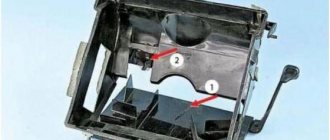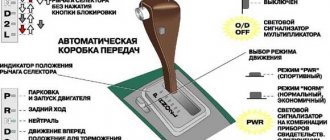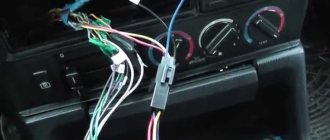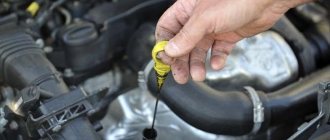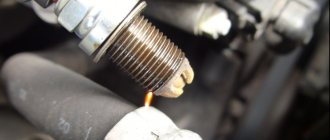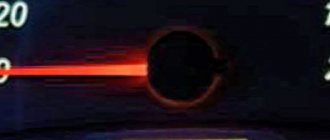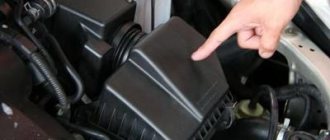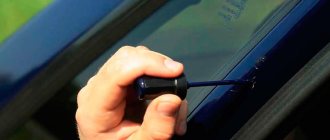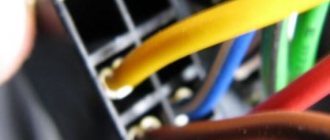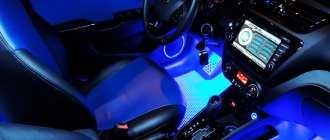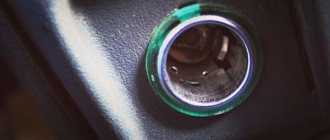A radio in a car is an integral accessory for the car interior, without which the trip may seem boring and monotonous to you. For many drivers, the radio in the car is a good “tonic” tool for keeping oneself in an alert state - the radio keeps them awake and entertains them during long trips.
But sometimes the radio begins to act up, receives the signal unevenly or poorly, hisses, strays from the set frequency, turns off and on spontaneously, works, sometimes louder, sometimes quieter - in general, it begins to irritate. Why does this happen, and how to return normal sound to the car interior?
Simple option
The easiest repair is in a situation where problems with signal reception are not due to mechanical or electrical damage, but to a simple failure in the settings. This may be caused by an imperfection in the radio's firmware or by the inept actions of the driver who accidentally pressed the wrong key.
Restoring everything is very simple, just conduct an automatic search for stations and save them in the device’s memory. The second option is to manually “drive in” the required frequencies and, if necessary, fine-tune.
Signal deterioration in the absence of damage can be caused by the proximity of a source of electromagnetic interference, or distance from the broadcast station.
For example, if a driver has stopped near a power line, or is moving along a city street hidden by multi-story buildings, or has gone far out of town, you should not be surprised that the radio has stopped picking up the desired frequency. It is enough just to change the location for everything to be restored by itself.
Possible breakdowns
If everything is in order with the settings, and there are no obstacles to the signal, there is a high probability that there are real problems.
If it becomes difficult to pick up the radio in the car, you need to pay attention to the following elements:
- External or internal antenna. Even seemingly insignificant impacts can break it. Random light impacts, heavy rain, freezing in winter - all this impairs performance. For example, if traces of corrosion are clearly visible on a part, they should be carefully removed with an abrasive brush.
- Contacts. The radio is connected by many wires connecting it to both the antenna and the vehicle's power system. Oxidation of even one contact or wire breakage will lead to inoperability. Integrity is checked visually; to do this, you will have to pull the receiver out of the mounting socket and carefully inspect all the parts. Creases, bends, oxide on the plug - the presence of these defects indicates that there is internal damage.
- Radio tape recorder. Yes, it may well break on its own. Vibration loads during movement, temperature changes, incorrect operation - all this produces a cumulative effect, sooner or later causing complete breakdown. If the device does not respond to presses and does not turn on when connected to the network, this option is quite acceptable. It is noteworthy that failure can happen with both an inexpensive Chinese radio and equipment from a famous brand.
Antenna replacement
If the inspection shows serious damage to the antenna that cannot be repaired on its own, it is better to completely replace the element, fortunately its price is low.
The classic option is an external telescopic antenna, which is installed in the basic configuration on almost all cars.
Its main advantages are low cost and fairly reliable reception of even a weak signal. However, there are many more shortcomings. Placing it outside the body makes the element vulnerable to many influences, temperature changes, shocks, moisture, snow, ice. Many drivers also believe that the part spoils the exterior of the vehicle and worsens its aerodynamics.
It is not surprising that the second type is gaining popularity - an internal antenna.
The internal device is usually mounted on the windshield and has compact dimensions, making it completely invisible. Practice, however, shows that in terms of efficiency it is quite capable of being compared with an outdoor antenna. If the module is not passive, but active, that is, it has a built-in signal amplifier, it is ahead of a standard external device in all respects.
Myths about setting up a good antenna signal
There is an opinion that the main reason for the lack of a good radio signal is a poorly tuned antenna. Now let's figure out whether this is true or not. In fact, for a good radio signal, you need to properly install the antenna by attaching it to the supporting body. In this case, setting plays a small role.
This is interesting: Deception in a car service: how not to get caught in a “scam”
There is a myth among motorists that after purchasing an antenna there is no need to configure it further. In fact, the antenna is installed and tuned to a specific machine. Therefore, you will have to take the time to set up the antenna for your car.
Self-tuning antennas do not exist , as some car owners think. When they are manufactured, such a function is simply not provided.
Choosing a new radio antenna and antenna amplifier
It happens that the antenna is already noticeably worn out, and the only way out is to replace it. In this case, the best solution is to buy an antenna for the specific model of your car. If you don't have one, you can choose a universal antenna
An important point: pay attention to the length of the mast, which must be at least 40 cm in length, as it guarantees adequate signal reception. If you often travel in suburban conditions, you can buy an additional signal amplifier installed between the radio receiver and the antenna
The question of an amplifier can be omitted by owners of VAG group cars (for example, VW, Seat, Volkswagen, Skoda, Audi), because the antennas installed in them have a signal amplifier built into the base of the antenna. However, if a non-standard player is installed, the reception quality may suddenly deteriorate. This is due to the fact that the factory receiver has a built-in device that transmits an additional signal through the antenna cable to the amplifier. Third-party equipment is not equipped with such an accessory, so you should additionally purchase a so-called antenna splitter, which completely solves the problem.
Eventually
The sources of problems with radio reception should be considered mainly in terms of the condition and installation of the antenna. However, keep in mind that poor sound quality can also be the result of a poor quality radio or worn-out car speakers.
>
Replacing a radio or amplifier
Basically, the radios that come with the car are quite high quality for listening to music and receiving radio broadcasts. But not all devices have similar qualities. Often, expensive equipment equipped with CD and DVD media with incredible sound quality has a poor radio tuner. And the equipment installed in premium cars is not always characterized by a high quality radio.
For example, drivers often face the problem that the radio in a Toyota car has poor reception. What to do in this case? Experts explain that some radios are not designed for the frequency range of our radio stations. To get rid of the problem, it is recommended to buy a new suitable radio or amplifier suitable for our country. In this case, it is necessary to remove the standard amplifier from the foreign car.
The radio reception in the car is bad: What should I do?
Every car is equipped with a radio that no driver can do without. Regardless of what media you like to listen to music in the car, any driver actually uses the radio in his car from time to time. But sometimes the radio receiver can let us down and begins to receive the radio signal poorly. Well, this certainly begins to irritate many drivers. What to do in such a situation and what could be the reason for the poor performance of the car radio?
Buying Guide: Available Accessories for Your Vehicle
If the radio in your car begins to poorly receive a radio channel, this does not always mean that the car’s equipment or radio antenna is to blame. After all, the source of interference can be tall buildings, cell phone towers along the road, and even a flare on the sun itself, which can also cause electromagnetic radiation.
In most cases, when there is poor reception of radio channels, the reason lies precisely in external interference, and not in breakdowns of the car’s radio equipment.
So, friends, do not rush to contact electricians with complaints about your car’s radio equipment. First, you need to find out what is the reason for poor radio reception. Here are five main ways you can improve the signal reception of your favorite radio channels.
Checking the wire connections
One of the most common causes of interference is a poor connection between the car radio and the antenna connector. This is due to the fact that if there is poor contact between the antenna cable and the receiver, the transmission of the radio signal deteriorates. As a result, the speakers produce radio noise and interference. This mainly happens during body vibration or corrosion due to moisture.
Therefore, if the quality of signal transmission has deteriorated, after inspecting the antenna, it is necessary to check the cable at the junction with the receiver. When the radio reception in the car is poor, what should you do in this case? The radio installation is removed from the car or pulled out from the center console to inspect the device at the rear, where the cable connector is located.
If, after a visual inspection, no problems with the connector were identified, you should wait to install the receiver back; perhaps the antenna cable has hidden damage. It is necessary to turn on the radio on the wavelength that is causing interference and turn up the volume to hear the noise. Then move the cable at the connector. If the sound does not change, then the problem is not in the cable connection. On the contrary, if crackling, whistling and other extraneous sounds appear, then the problem is in the antenna cable or connector.
The radio in the car doesn't work
Every modern car is equipped with a radio receiver. It is difficult to imagine a driver who can do without this industrial achievement. Sometimes a car radio upsets us by poorly receiving the signal and completely stopping making any sounds. How to deal with such a problem?
As soon as you notice that the radio in your car has become worse at receiving a signal or periodically stops working, the cause of the malfunction does not necessarily lie in the vehicle itself. Sometimes the problem lies in the radio antenna mounted on the car body. Serious interference to radio signals is caused by high-rise buildings, mobile operator towers, solar flares and other objects emitting electromagnetic fields.
Test the antenna
Most often, the radio in the car does not work precisely because of a malfunction of the external antenna. The external metal radio antenna installed on the vehicle body is most susceptible to mechanical damage. When it hits objects along the way, it begins to receive signals poorly or stops doing so altogether. Often the element is damaged during the cleaning of the body from contaminants at a car wash. Sometimes car washers move the antenna before starting treatment, and then forget to return it to its original position. During the cold season, the performance of the mechanism may be affected by ice formed on its surface.
While parking, a bird may try to land on the antenna, which will also damage the element. Any subtle deformations that we do not attach importance to can lead to a deterioration in the quality of radio signal reception. First of all, inspect the structure and extend the antenna completely if it was folded. Free it from snow and ice - the main sources of interference.
If the problem occurs in winter, do not try to pull out the antenna with a handy tool. Inexperienced drivers often use pliers for these purposes, which leads to damage to the antenna housing and the entire electromechanical mechanism for its extension.
Evaluate the reliability of your antenna connections
The signal may disappear when the car receiver is poorly connected to the connector of the antenna itself. An unstable connection between the antenna cable and the radio leads to an immediate drop in the quality of the radio signal. Instead of music and programs, you will hear only interference or silence on the radio.
During the operation of a car, its body is subject to numerous vibrations. They provoke loosening of wire connections. Moisture entering the contacts provokes the development of corrosion processes. These phenomena are also typical for the connectors that connect the antenna and the radio. The driver loses the ability to configure the equipment for high-quality signal reception.
To conduct a visual inspection of the cable connecting the radio and antenna, it is necessary to dismantle the radio installation or push it forward from the instrument console. You need to focus your attention on the rear of the tuner, which is the most vulnerable part.
If a visual inspection does not help to identify the cause of the malfunction, do not rush to put the radio in its original place. The connector or cable may receive damage hidden from the human eye. Turn on the radio and try moving the antenna cable that goes to the radio. If the connection is tight and reliable, this will not give any result. If such manipulations help to find the position of the cable at which the radio starts working, then it is necessary to replace the connection connector and the antenna cable itself.
Replace the radio antenna
Traces of rust, tears and dents on the radio antenna indicate the need to replace the element. Only this will help restore high quality signal reception. Often, rust affects not only the mast, but also the antenna connectors where the cable connecting to the radio tuner is connected.
In modern cars, new types of radio antennas are installed. They are made in the form of a mesh sticker, installed on the windshield or rear window of a car. Flat elements are aesthetically more attractive compared to their predecessors. They are located inside the car interior, so the possibility of mechanical damage to the mechanism is minimized.
The main problem with flat antennas is the low quality of signal reception. This is especially true when located in large cities and hilly areas. Damage to the mechanism creates the need to replace it with a new one.
Use radio signal boosters
Sometimes you can restore normal radio signal reception by installing an amplifier. This becomes irrelevant if the mechanism breaks down, is excessively worn, and contacts are deformed. Amplifiers help solve the problem only in situations where the equipment is working properly.
Check the radio
If the previous manipulations did not help resolve the problem, then there is a high probability of a breakdown in the radio itself.
Source: https://avtolife.net/ne-rabotaet-radio-v-mashine/
Why does the radio recorder poorly pick up the radio signal?
Do not forget that when a car is in motion, it is initially difficult for it to catch and “hold” a radio wave that is rebroadcast from a distant repeater or supplied from a low-power radio transmitter (a problem with many local radio stations). In this case, the sound quality will constantly “float” depending on where the car is at a particular moment - on a hill or in a hole.
In addition, in recent years, the quality of radio signal transmission has been increasingly affected by extraneous interference created by mobile operator towers, powerful sources of industrial radio emissions, reinforced concrete buildings, and even electromagnetic storms in the sun.
In this situation, your radio will behave differently with different radio channels: the more powerful the radio station signal, the more difficult it is to clog it with interference. But if poor reception is observed on any of the included channels, you should think about the quality or serviceability of your receiving equipment on the machine.
How to fix poor radio reception in a car
How to determine the cause of poor radio reception? There are several simple methods that do not require contacting electrical and radio equipment specialists:
Checking the serviceability of the receiving radio antenna
An external metal antenna installed on the body of a car is always vulnerable - it can be moved, folded, damaged or broken by hands, by accidental contact with hard objects when carelessly driving through a narrow, low gate or garage. A bird could hit it, or car wash workers could get caught in it.
In winter, the antenna may be moved or damaged by heavy snow or ice.
In any case, if the radio signal becomes poor, start by checking the outdoor antenna, and in 50% of cases it will be the cause of poor reception and unstable signal. An antenna that is not fully extended is another cause of interference and interruptions.
If, during inspection, you find that the antenna arm is not fully extended, you can carefully extend it yourself. If it is broken, it is better to contact specialists who can fix it or replace it. If the antenna body is covered with rust, then it is better to replace it as well.
Checking the Antenna Connection
If the antenna itself is intact, correctly extended and rotated, check the connection of the antenna connector, through which the signal is transmitted to the receiver-tuner in the cabin. If the wiring is broken, you will periodically hear noise, and if there is a break, the signal may stop flowing altogether.
Damage to the connection, disconnection or breakage of the radio antenna wire is a common occurrence: your car is in constant motion, and the body transmits all types of mechanical vibrations to the connection. If the connector has simply come off, returning it to its place and fixing it is a matter of seconds; breaking the contact will require fine soldering or a new connection. If rust is found on the connectors, they should be cleaned.
Checking the connecting cable
The cable leading from the antenna connector to the radio tuner may also become damaged or disconnected from the radio. Move the wire - if the signal appears and disappears, pull the radio out of the socket and inspect the connection connector on the back of the case. If it comes off, turn it into the socket; if the connector is in place, then you may have to change the cable itself.
Checking and replacing the radio
If the receiving devices, wiring, connections and connectors are in order, all that remains is to check the radio itself for mechanical damage or internal breakdowns. If you understand radio engineering, you can quickly detect a malfunction (boards, buttons, switches, frequency scale), if not, take it to a service workshop for diagnostics.
The best option is to install modern, more expensive radios from proven foreign manufacturers with a good acoustic system. Such radios are equipped with built-in signal searchers and internal radio wave amplifiers.
Radio signal too bad
Perhaps the most common reason why the radio in the car has poor reception. A weak signal is a problem that car owners everywhere face far beyond the city limits. The thing is that broadcasting towers are too far away, and the analog signal is far from ubiquitous. It doesn't reach your radio for several reasons. This is the spherical shape of the Earth, and various obstacles - tall buildings, landscapes, plantings, etc.
However, a bad signal does not mean a complete absence of one in the reception area. Despite numerous obstacles, radio waves can still travel very far. But with increasing distance and the number of obstacles passed, the signal weakens. Accordingly, if the radio does not pick up well for this reason, the radio waves available “around you” just need to be “caught” more carefully and, possibly, amplified.
How to make sure that the radio in the car has poor reception precisely because of a weak signal? Very simple. You need to check how the reception works somewhere closer to the broadcast tower. As a rule, they are located in cities and other large populated areas. If in such areas your radio starts to work normally, but where you live it hisses and does not receive reception, then the reason is a weak signal.
This problem can be solved in several ways. Again, active antennas, which everyone relies on, are far from a panacea here. It is quite possible that in your case, to reliably receive a weak radio signal, a functional passive mast and elimination of interference will be sufficient. This is discussed a little below.
In general, if the signal is clearly bad, then a high-quality active antenna will help to amplify it qualitatively and reproduce it without interference. Just remember that good quality and cheap are two parameters that cannot intersect in any way in the same model. In practice, it has been proven that Chinese “active” boxes at an attractive price do not enhance anything. And sometimes they generate such interference that the desire to listen to the radio in the car disappears completely and for a long time.
Brief summary
In conclusion, we will compile a summary table with all the common reasons why radio reception is poor, and ways to eliminate them.
| Why is the radio bad? | What to do |
| Radio doesn't work at all | Test the radio for functionality within the city, using a transmitter or in another car. |
| Signal too weak | Install and connect the passive antenna with the correct cable. If the fishing is bad anyway, buy a good active one. |
| Signal too strong | If the radio signals overlap each other or there is interference, install a noise filter in the gap in the antenna cable. With high-quality radios, there are usually no such problems. |
| Dead passive antenna | It may be missing, disconnected, connected incorrectly or with a damaged cable. |
| Damaged cable | Connect the antenna with a shielded cable. Make sure the cable is working properly by testing it. |
| Freelance devices | Devices such as a video recorder, radar detector, or mobile phone charger create interference. You can protect yourself from them either by filters or by eliminating the source of interference. |
| Poor quality radio | It’s not always the case that an inexpensive radio tape recorder has poor radio reception. This can be checked by disassembling and examining the wiring of radio microcircuits. |
| Indirect radio interference | Mobile communications, Wi-Fi, microwave ovens, industrial equipment, high-voltage power lines, etc. significantly clog up the radio airwaves. If the radio reception is poor because of this, then external noise filters or purchasing a high-quality radio can help. |
| Interference on the power line | They are solved by installing an interference suppression filter in the power supply circuit of the radio. Good radios already have such filters inside. |
| Bad active antenna | As a rule, cheap active antennas do not solve the problem if the radio in the car has poor reception. It is better to refuse to buy them altogether. |
As a result, we see that the radio has poor reception in the car for various reasons. Most often this is a weak signal. However, there are often cases when the reason lies in interference. Therefore, before spending money on an expensive radio or active antenna, work through all the possible reasons for poor radio reception. Perhaps the problem can be fixed for free.
How to improve the signal
When wondering what to do if the radio signal is bad and unstable, the first step is to determine the cause of the problem. Next, you need to use one of the available methods to improve reception.
For example, sometimes interference disappears after installing an active antenna, which is equipped with an additional amplifier. A homemade power filter is also attached to the radio. You can make it yourself using improvised materials. To do this, you need to make a couple of turns of a thin cable on the ferrite core. One end of the inductor is connected to the power source, and the other to an oxide capacitor or a plus plug from the car radio.
Then the finished structure is fixed in a small stainless steel or tin case and connected to the mass. You will also need to undersell the negative terminal of the capacitor.
The efficiency of signal filtering depends on the number of turns. Accordingly, the more there are, the cleaner the reception.
A good filter is able to suppress any interference that occurs in the power circuit. If after performing these steps the problem remains, you need to figure out ways to eliminate noise due to the operation of an electric motor or electronic devices inside the car.
Purchasing and replacing an antenna
A good way to improve radio reception in your car is to buy an antenna. Modern antenna models are compact in size and are fixed inside the car, so they are not exposed to precipitation. However, if the windshield is damaged, the antenna will also have to be replaced.
Having selected the desired antenna model, you must connect it in accordance with the instructions. First of all, you need to fix the base with the reception sensors on the windshield, maintaining a distance of 25 mm from the body frame. Otherwise the signal will be bad.
Next, the active antenna module is installed. At this stage, the power cord needs to be plugged into the radio plug. It comes in blue with a white stripe.
Amplifier installation
To strengthen the antenna signal, you can purchase special amplifiers. They are designed to improve reception over long distances from a radio tower or transmitter. In tandem with an amplifier, the standard antenna becomes highly sensitive, which has a positive effect on the sound and reduces the amount of interference.
Replacing the radio
If the sound floats when listening to the car radio, the noise becomes intense, and the sound is accompanied by strong interference in the speakers, the possibility of failure of the device cannot be ruled out. Cheap Chinese systems suffer from this problem much more often than advanced Japanese devices, including the Viget 6906 (Toyota). What you can do to improve the sound quality and timbre is to connect a new car radio.
Skoda Club Belarus (Skoda car lovers club)
Unshielded cables emit noise due to common-mode noise flowing through their copper conductors, that is, high-frequency current flowing in the same direction throughout all cable conductors. This current creates a magnetic field of a certain magnitude and direction.
Ferrite is a ferromagnet that does not conduct electric current (that is, in fact, ferrite is a magnetic insulator). Eddy currents are not created in ferrites, and therefore they are very quickly remagnetized - in time with the frequency of the external electromagnetic field (the effectiveness of their protective properties is based on this).
Cable ferrite attenuates noise currents by trapping the magnetic field and dissipating some of its energy as heat. In electrical engineering terms, a ferrite element placed on a cable creates a high active impedance for common-mode currents.
Previously, costly shielding of cables with copper braid was used to attenuate noise currents.
The use of cable ferrites has reduced the cost of cable shielding and increased the efficiency of interference suppression.
At first, these ferrite filters appeared on monitor cables (naturally: after all, the quality of the “picture” is greatly influenced by all sorts of interference!), then they gradually spread to other peripherals, and now almost all cables are equipped with ferrite filter cylinders: monitors, printers, scanners, photocopiers, video cameras, digital cameras, keyboards and even cable mice.
Ferrite rings without a shell can also be found inside the system unit.
How to Increase the Noise Reduction Effectiveness of Cable Ferrite
1. Increase the length of the cable part covered by the ferrite core.
2. Increase the cross-section of the ferrite core.
3. The inner diameter of the cable ferrite should be as close as possible (ideally equal) to the outer diameter of the cable.
4. If the design features of the cable-ferrite pair allow, you can make several turns (usually one or two) of the cable around the ferrite core.
To summarize the above, the best ferrite core is the longest and thickest that can be placed on a particular cable. In this case, the internal diameter of the cable ferrite should, if possible, coincide with the external diameter of the cable.
How to use cable ferrite
Sometimes on sale you can find detachable cable ferrites in a plastic shell (heat-shrink tube) with two latches. How to use them?
The open ferrite cylinder is placed on the cable, which must be protected from electromagnetic interference and interference, approximately 3 cm from the cable tip. A loop is made around the cylinder shell. After this, the shell snaps into place. For reliability, you can equip the other end of the cable with a ferrite cylinder.
Replacing the radio
If, after numerous checks of the functionality of all connections and the antenna, the signal remains weak, then most likely you will have to change the radio. But how to understand the huge variety of all kinds of devices for playing radio.
There is an opinion that any Chinese radio receiver does not pick up the radio well. This is actually a misconception. There are models in different price categories on the electronics market. In addition, competition in such markets is too high and it is not profitable for manufacturers to produce low-quality goods.
Radio Pioneer
Pioneer radios have proven themselves well in terms of the quality of reception and processing of radio signals in the car
And yet, when buying a new radio, pay attention not only to the manufacturer, but also to the price component
So we have looked at the main points related to poor-quality radio signal reception. Always check the condition of your external radio before traveling. And before you sin on your favorite radio station, remember the above, maybe the problem is not in your radio at all, maybe it lies on the surface, and in the everyday bustle we simply stopped noticing it.
Purchasing and replacing an antenna
If, after checking all contacts and connections, as before, the radio does not pick up the radio signal well, we proceed to more decisive actions. You need to decide to buy a new antenna.
Auto antenna
Antennas are:
- external;
- internal.
External antennas are not picky to use and have good radio signal reception. But they are more often internally susceptible to mechanical damage.
Internal antennas are more popular among car enthusiasts. Most of them are equipped with a built-in amplifier, and placing such an antenna in absolutely any car, be it a Nissan Beetle, Ssang Yong Chiron or FF2, will not be difficult. Typically, such antennas are placed at the top of the windshield.
Possible faults
First, let's try to determine what caused the poor signal reception by the car radio.
The reasons may be varied. Here are perhaps the most common:
- antenna malfunction. The antenna can be damaged from the outside, this especially often happens in winter. The antenna plug may move away from the connection socket on the radio body due to vibration of the car when driving;
- the location of radio signal broadcasting devices at a very long distance or the presence of natural barriers along the way: mountains, large and tall buildings;
- presence in the immediate vicinity of power lines, railroads, cell phone towers and other electronic interference;
- failure of the radio tuner itself in the receiver. This can happen both in budget radios and in standard premium systems.
Checking the antenna
If a metal antenna is installed in the car, then one of the reasons for the poor signal may be its damage.
This situation is possible for the following reasons:
- after washing a vehicle, car wash workers sometimes damage the antenna or simply forget to push it back, which also interferes with receiving a radio signal;
- birds often deform the antenna in the parking lot;
- In winter, the device may become icy;
- hail can bend the antenna.
Drivers should remember that even minimal damage to the antenna leads to a deterioration in signal reception. Therefore, at the first sign, it is necessary to check the retractable element.
If the antenna has an electrical mechanism and is extended by pressing a button, then icing may interfere with the process and the radio signal will not be received with interference.
If the antenna is frozen during icing, then you cannot use force to return it to its normal state, especially using pliers.
1) Check the car antenna
If your car is equipped with an external metal antenna, there is always a risk of damage to it, which will certainly lead to a deterioration in the quality of radio signal reception. For example, an external retractable antenna can get damaged at a car wash (car wash workers often move the antenna to avoid damaging it and then simply forget to retract it again). It can also be damaged by large birds living in the parking lot. Or else, the antenna in your car may become damaged due to the normal formation of ice during the winter season. This can especially happen during freezing rain, which can easily bend the car's antenna and even break it completely. Remember, friends, that even minor, unnoticeable damage to the external retractable antenna can significantly degrade the quality of radio signal reception.
Therefore, remember for the future, at the first sign of a drop in the quality of radio reception of the radio, you need to check the condition of the external car antenna.
It is likely that the external antenna of the car is simply not fully extended and therefore radio channels are received with interference. In this case, you just need to extend the antenna according to the car manual.
If your vehicle is equipped with an electric antenna that extends and retracts using a button, ice buildup may cause the antenna to not extend fully or completely. In this case, the signal will also be received with interference. Unfortunately, on many car models, antennas are usually installed out of the driver’s field of vision and you may simply not notice that the antenna is not fully extended. Therefore, in case of poor radio signal reception, be sure to check the condition of the antenna itself.
Let's start troubleshooting
You need to start by inspecting the antenna for damage. Even the most insignificant, at first glance, little things, such as bending, traces of oxidation or other mechanical damage can cause poor signal reception.
Car radio cords
Make sure that all contacts are tightly secured, the plug is firmly installed in the radio socket and has no visual damage. To do this, you need to remove the radio from the dashboard and carefully inspect the rear part, check the tightness of the contacts and connections.
Carry out troubleshooting in areas where there is no radio interference. Leave the area of power transmission towers, move away from railroads and tall buildings. Try retuning the car radio in your car by searching for radio stations. Some Chinese players may be affected by modern gadgets. In close proximity, they can affect low-quality standard assemblies and create interference on the radio.
How to connect and configure the radio correctly
Connecting a radio to your car yourself is easy. All you need to do is remove the car radio plug from the box and follow simple connection steps. After this, you can try tuning the radio on the radio.
By going into the settings, you can see the items AM/FM1/FM2. They allow you to turn on the radio or select the desired band manually.
Changing the search frequency is also carried out using simple buttons that are located nearby and in most cases are triangular brackets with an up and down direction. A similar button arrangement is present in every music center.
Car radios are also equipped with buttons for programming or changing stations. You can store your favorite radio stations in memory and switch them using one of the digital buttons.
To play, just press the Power button and select the desired item in the list of stations. Basically, there are no difficulties in setting up a car radio, and even an inexperienced motorist can figure out this procedure without much difficulty.
Basic radio settings
Before you set up the radio on the radio, you should make sure that the antenna is installed on the car. Her choice depends on the reception conditions. In large cities where there are powerful transmitters or repeaters, you can install a cheap and simple whip antenna.
If the radio tower is located at a distance of 20-70 km from the receiving location, an in-cabin active antenna with an amplifier should be installed to improve radio reception. Japanese radios receive stations in the range of 76-90 MHz. Before connecting the radio to such a device, a converter is installed. The accessories included with Pioneer radios will help you set up and connect the device to any car.
To perform automatic tuning on most radios, press the “right” key. The tuner will scan the band until it finds a station with a strong signal. All radios have memory cells into which you can save your favorite radio stations. To do this, press and hold one of the buttons with numbers from 1 to 6 located on the front panel. The number of the saved radio station will appear on the display.
If the radio signal level is not enough for the desired station to be detected during auto search, you can resort to manual tuning. In some radios it is turned on through the settings menu, and in others - by pressing and releasing the “left” or “right” buttons. You can determine which stations will be well received in the car at home, on a stereo system. You can also perform auto memorization search. On a Pioneer player, this procedure requires pressing the Func key until BSM mode is selected. After this, press the “up” or “right” key.
In this case, the tuner will scan the entire range for stations with strong signal strength. Each of them will be recorded in its own memory cell, starting from the first. On many radios, stations found in this mode are played for 2 seconds, after which scanning will continue until the end of the range.
Additional signal amplifier
In some regions, even a working, powerful radio system has poor signal reception, since local transmitters and repeaters are either low-power or located far away. In this situation, a weak radio will find it very difficult to pick up the radio signal.
An additional signal amplifier solves the problem. It enhances the amplitude of received radio waves and makes reception stable. But keep in mind that if the main radio equipment of the car is of poor quality, or the geolocation is unsuccessful (in a lowland, surrounded by high-rise buildings, in close proximity to other sources of radio interference), it is unlikely to help you.
To prevent the radio system from malfunctioning, you should handle the equipment correctly, check it regularly, do not leave it turned on in the cabin overnight, remove dust and dirt if necessary, clean it and replace worn out parts in a timely manner.
If no damage is found in the devices themselves, you should look for internal damage or misconfigurations. The easiest way is to completely replace the radio system by installing a high-quality, latest generation radio and a new external receiving antenna. You can also give the equipment to specialists for testing and repair.
Checking the performance of the antenna
When the radio reception in a car is poor, not all drivers know what to do. If the antenna has been checked for external damage and there are no complaints about the wire connections, then it is worth making sure that the signal receiving device itself is working.
If dents, rust or similar damage is found on the antenna, the device must be replaced with a new one.
Modern cars are equipped with a mesh antenna that is glued to the rear or side windows. Such a device has an aesthetic advantage over an external antenna, but does not differ in the quality of radio signal reception. Also, the sticker can be damaged from the inside, for example by children. In this case, you will have to buy a new one.
Possible reasons for a bad signal
It’s not difficult to figure out why the radio doesn’t pick up the radio. First of all, the problem is explained by malfunctions in the antenna. If the cable shield is damaged, the signal will be of low quality with a lot of interference. If the wire has been deformed or broken, the connector has become loose, or the plug that is inserted into the radio has come off, the radio may stop functioning altogether.
When using an active antenna, poor signal reception quality will be due to the lack of power connection to the amplifier. Another problem is explained by poor contact between the receiving dipoles and the amplifier module, which occurs as a result of oxidation processes or deformations.
The next reason why radio reception is poor is a large distance between the repeater or radio tower and the receiver or strong interference of artificial and natural origin, which prevents the normal movement of the signal.
Sometimes motorists notice that the signal deteriorates after starting the windshield wiper, heating system or washer.
Budget radio models made in China begin to malfunction and experience interference due to the presence of other electronic systems in the cabin. This often happens after starting the DVR.
Well, one of the most common causes of interference is problems with the tuner itself. Also, as the system is actively used, damage to the speakers occurs. As a result, they produce wheezing and crackling noises that interfere with the normal setup of the radio.
Replacing the radio
If, after checking all the radio tuner equipment, the cause of the weak signal has not been identified, then most likely you cannot avoid replacing the radio. A cracked circuit board is the most common cause of radio failures.
When choosing a new radio, focus attention not only on its price, but also on the manufacturer’s brand
It is important to remember that cheap models will not provide stable radio signal reception!
Poor radio reception is one of the most annoying situations audiophiles can encounter in their car. Fortunately, you can deal with this problem quite easily. All you need is a little logic and skillful hands.
Signal amplifier
Typically, if radio signal reception is poor, using an amplifier is ineffective. Especially if poor quality sound is caused by damage to the antenna, wear of the cable or connector. However, as a rule, this leads to deterioration of the radio signal of all channels.
However, there are times when new equipment is installed, and some channels continue to broadcast with interference. If the radio reception in the car is poor, what should you do about this problem? Each radio channel has a different transmitted signal strength and is therefore received differently by the radio device. In this case, the use of a signal amplifier is quite justified
At the same time, it is important to clarify that the amplifier cannot cope with interference caused by high-rise buildings or due to the terrain.
4) Install a radio signal amplifier in the car
Usually, in the case of poor-quality radio signal reception, the radio amplifiers installed in the car are not very effective. Especially when the reason for the poor-quality sound of a radio channel is due to a broken antenna or wear of the antenna cable or connectors. But usually with this type of damage, poor reception of all radio channels without exception is observed.
But sometimes, even with working radio equipment, each driver may encounter uncertain reception of just a few radio channels. What then should be done in this case? Indeed, the power of the radio signal from all radio stations is different and radio channels can indeed be received differently by our car radio equipment. How, then, can you tune your favorite radio channel to high-quality sound?
In this case, radio amplifiers can come to your aid. But remember, friends, that if this interference when receiving a radio station is associated with high-rise buildings or terrain features, then no radio signal amplifier will help you.
